INFOMARK IMW-C870W WiMAX Jacket for IPod User Manual UM SAR gap
Infomark Co., Ltd. WiMAX Jacket for IPod UM SAR gap
INFOMARK >
User Manual
IMW-C870W
User Manual
Table of list
Chapter 1. Attention ................................................................................................................................................ 4
Chapter 2. Introduction & Requirements ........................................................................................................ 4
Introduction of goods ......................................................................................................................................... 4
What is the IMW-C870W ? ......................................................................................................................... 4
System Requirements. ................................................................................................................................. 4
Specification ..................................................................................................................................................... 4
Application ......................................................................................................................................................... 5
The points of name & Components list ...................................................................................................... 5
Components List in the package. ............................................................................................................. 5
Points of name & Function .......................................................................................................................... 5
Chapter 3. How to use the IMW-C870W ........................................................................................................ 7
Power ON/OFF .................................................................................................................................................... 7
How to charge battery ....................................................................................................................................... 7
Setting of the WiFi AP ....................................................................................................................................... 7
Setting with Window XP ............................................................................................................................... 7
Setting with Window 7 .................................................................................................................................. 8
Setting with Mac OS ...................................................................................................................................... 8
Setting of USB (RNDIS) ................................................................................................................................... 9
Setting with Window XP ............................................................................................................................... 9
Setting with Window 7 ............................................................................................................................... 10
Chapter 4 Configuring CM ................................................................................................................................ 11
Connect to Web CM (Web Connection Manager) .............................................................................. 11
Start CM .......................................................................................................................................................... 11
Input ID ............................................................................................................................................................ 11
Description of Web User Interface ............................................................................................................ 12
Status ................................................................................................................................................................. 12
Device Setup ................................................................................................................................................. 13
Setup Wizard ..................................................................................................... 錯誤
錯誤錯誤
錯誤! 尚未定義書籤
尚未定義書籤尚未定義書籤
尚未定義書籤。
。。
。
Windows Xp driver .......................................................................................... 錯誤
錯誤錯誤
錯誤! 尚未定義書籤
尚未定義書籤尚未定義書籤
尚未定義書籤。
。。
。
Password ............................................................................................................ 錯誤
錯誤錯誤
錯誤! 尚未定義書籤
尚未定義書籤尚未定義書籤
尚未定義書籤。
。。
。
Device Time ....................................................................................................... 錯誤
錯誤錯誤
錯誤! 尚未定義書籤
尚未定義書籤尚未定義書籤
尚未定義書籤。
。。
。
Reset Device ..................................................................................................... 錯誤
錯誤錯誤
錯誤! 尚未定義書籤
尚未定義書籤尚未定義書籤
尚未定義書籤。
。。
。
Device Update ...................................................................................................... 錯誤
錯誤錯誤
錯誤! 尚未定義書籤
尚未定義書籤尚未定義書籤
尚未定義書籤。
。。
。
User upgrading ................................................................................................. 錯誤
錯誤錯誤
錯誤! 尚未定義書籤
尚未定義書籤尚未定義書籤
尚未定義書籤。
。。
。
Wi-Fi Settings ........................................................................................................ 錯誤
錯誤錯誤
錯誤! 尚未定義書籤
尚未定義書籤尚未定義書籤
尚未定義書籤。
。。
。
Basic ..................................................................................................................... 錯誤
錯誤錯誤
錯誤! 尚未定義書籤
尚未定義書籤尚未定義書籤
尚未定義書籤。
。。
。
Advanced ............................................................................................................ 錯誤
錯誤錯誤
錯誤! 尚未定義書籤
尚未定義書籤尚未定義書籤
尚未定義書籤。
。。
。
Advanced Settings .............................................................................................. 錯誤
錯誤錯誤
錯誤! 尚未定義書籤
尚未定義書籤尚未定義書籤
尚未定義書籤。
。。
。
4G Information .................................................................................................. 錯誤
錯誤錯誤
錯誤! 尚未定義書籤
尚未定義書籤尚未定義書籤
尚未定義書籤。
。。
。
Firewall ................................................................................................................. 錯誤
錯誤錯誤
錯誤! 尚未定義書籤
尚未定義書籤尚未定義書籤
尚未定義書籤。
。。
。
Router ................................................................................................................... 錯誤
錯誤錯誤
錯誤! 尚未定義書籤
尚未定義書籤尚未定義書籤
尚未定義書籤。
。。
。
System ................................................................................................................. 錯誤
錯誤錯誤
錯誤! 尚未定義書籤
尚未定義書籤尚未定義書籤
尚未定義書籤。
。。
。
Device Log .......................................................................................................... 錯誤
錯誤錯誤
錯誤! 尚未定義書籤
尚未定義書籤尚未定義書籤
尚未定義書籤。
。。
。
Help ........................................................................................................................... 錯誤
錯誤錯誤
錯誤! 尚未定義書籤
尚未定義書籤尚未定義書籤
尚未定義書籤。
。。
。

Chapter 1. Attention
Don’t use in high humidity place.
Use in the clean place.
Install on the safe place without dropping.
Don’t use and keep around electromagnetic waves.
Don’t put the goods on heavy things.
Don’t install and use in the Sun lights directly.
Don’t throw or dismantle the goods.
Don’t heat the goods and battery.
Protect the goods from pets and children.
Don’t put the goods and battery in the water.
Don’t hold power adaptor in the wet hands.
Chapter 2. Introduction & Requirements
Introduction of goods
What is the IMW-C870W ?
IMW-C870W is a mobile WIMAX iPod4G Jacket Router device and a very inventive product
for Portable Mobile WiMAX & WiFi Dual CPE(Customer Premises Equipment) enabling
solution of the problem of lack in user terminals possible to use Mobile WiMAX service.
When IMW-C870W is left in pocket or bag with its power on in the area where Mobile
WiMAX service is available, user can make concurrent connection to many WiFi terminals by
using WiFi transmitted by IMW-C870W , so it enables free use of wireless internet in any
area.
IMW-C870W included WiFi AP support Mobile WiMAX Service through WiFi can be
supported portable devices (Laptop, Desktop, PDA and Smart Phone etc.)
System Requirements.
User’s device will be installed WiFi (IEEE 802.11b/g) LAN Card or module.
The PC will be Installed USB port.
Specification
Items Description
WiMAX WiMAX Standard Compliance IEEE 802.16e-2005
Air Interface Internal Antenna(0dBi)
Max output Power 23dBm
WiFi Network Standard IEEE 802.11 b/g
Frequency/Channels 2.4GHz/5Ch.
Power Battery Built-in Li-Ion(3.7V/1390mA)
Adaptor 5V / 2A
Dimension / Weight 113.4.0mm(L)×63.3mm(W)×16.2mm(T)
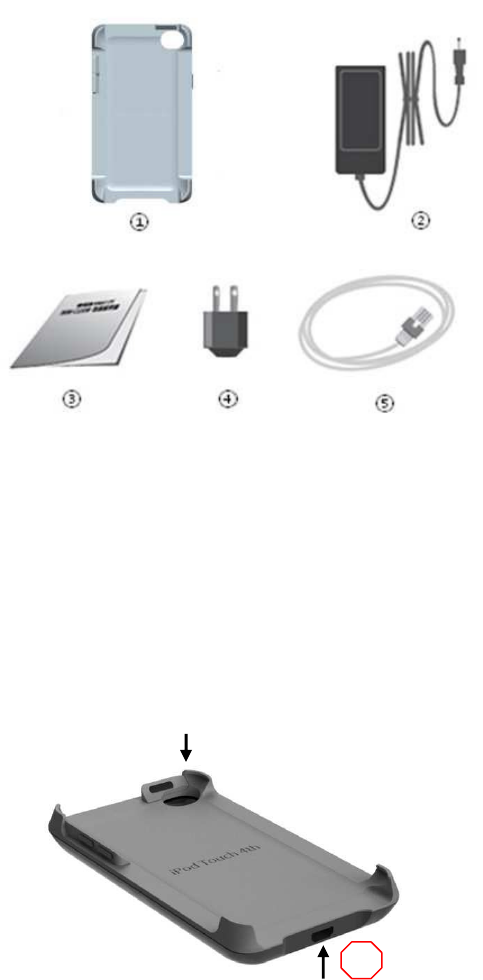
Application
All device including WiFi 802.11b/g such as;
Personal computer (Desktop and Note PC)
Smart Phone
Tablet PC and iPad
Game palyer
The points of name & Components list
Components List in the package.
① IMW-C870W
② Adaptor [5V / 2A] (Optional)
③ User’s Manual
④ Plug
⑤ USB Cable
Points of name & Function
ipod camera hole
1
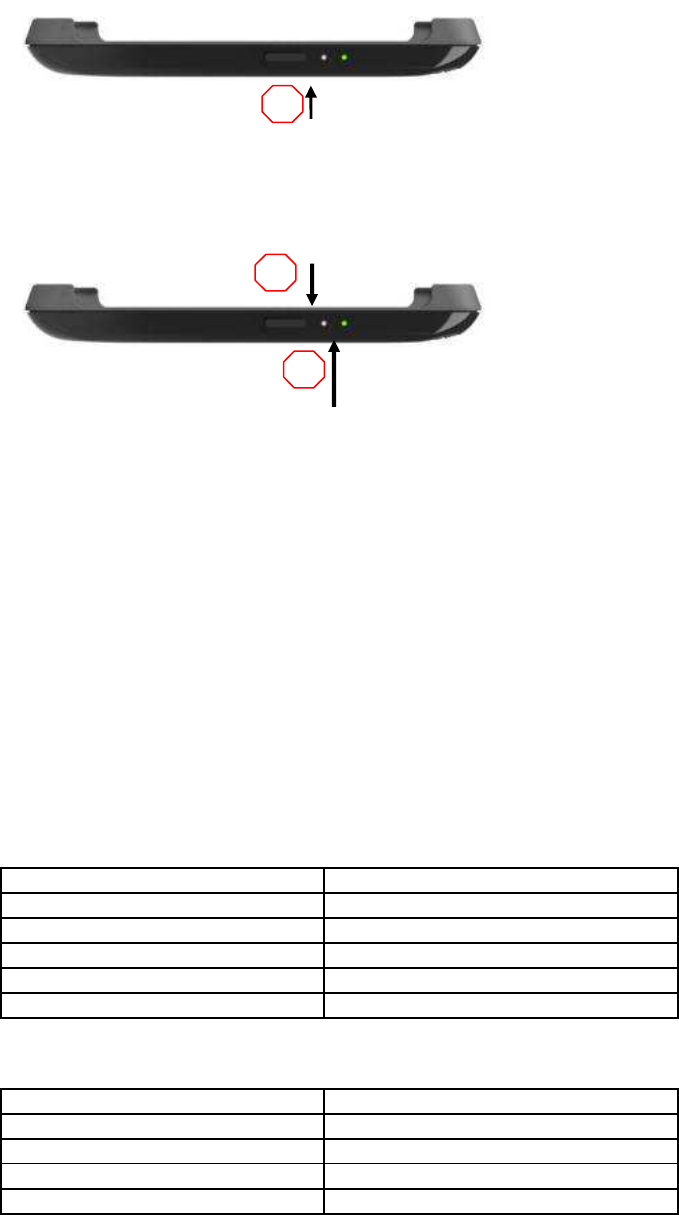
Micro USB Connector
C870 Power Button
Battery Status
WiMAX Status
① USB Port : Battery charging and Tethered operation
② Power button
Press : Power on & off
③ Battery Status : battery status and power (Color : Orangew / Green / Red)
④ WiMAX Status: WiMAX Signal strength (Color : Orangew / Green / Red)
LED Status Scenario
WiMAX Signal LED
Off Power Off
Orange LED On and Off Frequency scanning or ready
Red LED On and Off Connecting with WiMAX network
Red LED On WiMAX signal level 1
Orange LED On WiMAX signal level 2 ~ 3
Green LED On WiMAX signal level 4 ~ 5
Power LED
Remained battery (100% ~ 50%) Green color
Remained battery (50% ~ 20%) Orange color
Remained battery (20% ~ 0%) Red color
Battery charging Red color
Battery full charging Green color
2
3
4
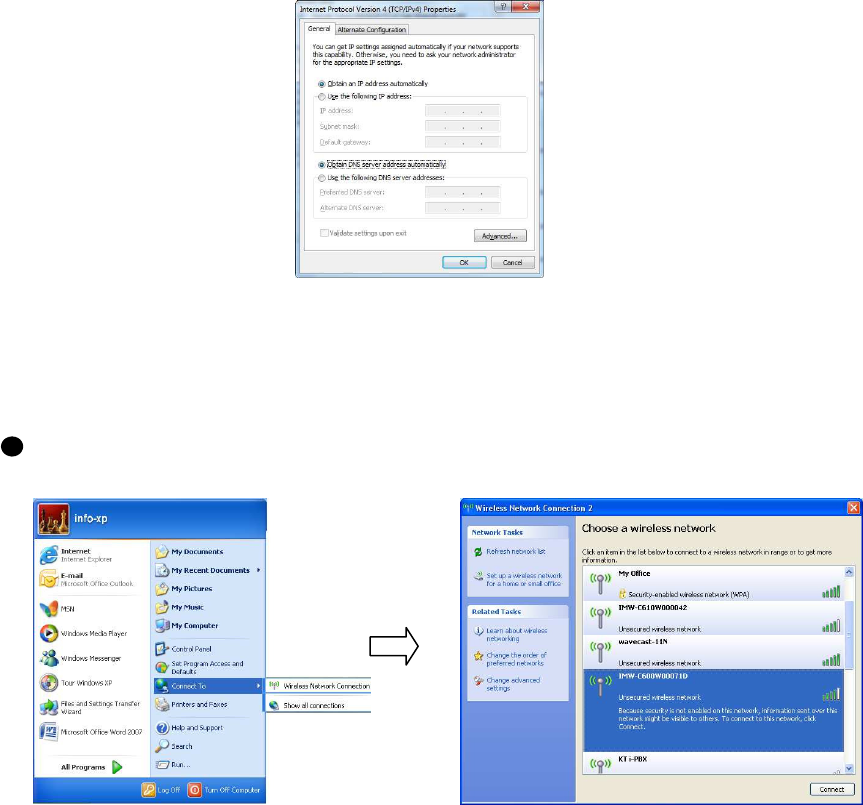
Chapter 3. How to use the IMW-C870W
Power ON/OFF
Power ON : Press the power switch for 3 Seconds.
Power OFF : Press the power switch for 5 Seconds.
How to charge battery
The built-in battery can be charged from either USB cable or wall Charger (Optional)
Setting of the WiFi AP
Notice : Configuration of WiFi AP has to be set to “Obtain IP address and DNS sever address
automatically”.
Setting with Window XP
<Start> <Connect to> <Wireless Network Connection> Choose WiFi AP of IMW-C870W
in the list
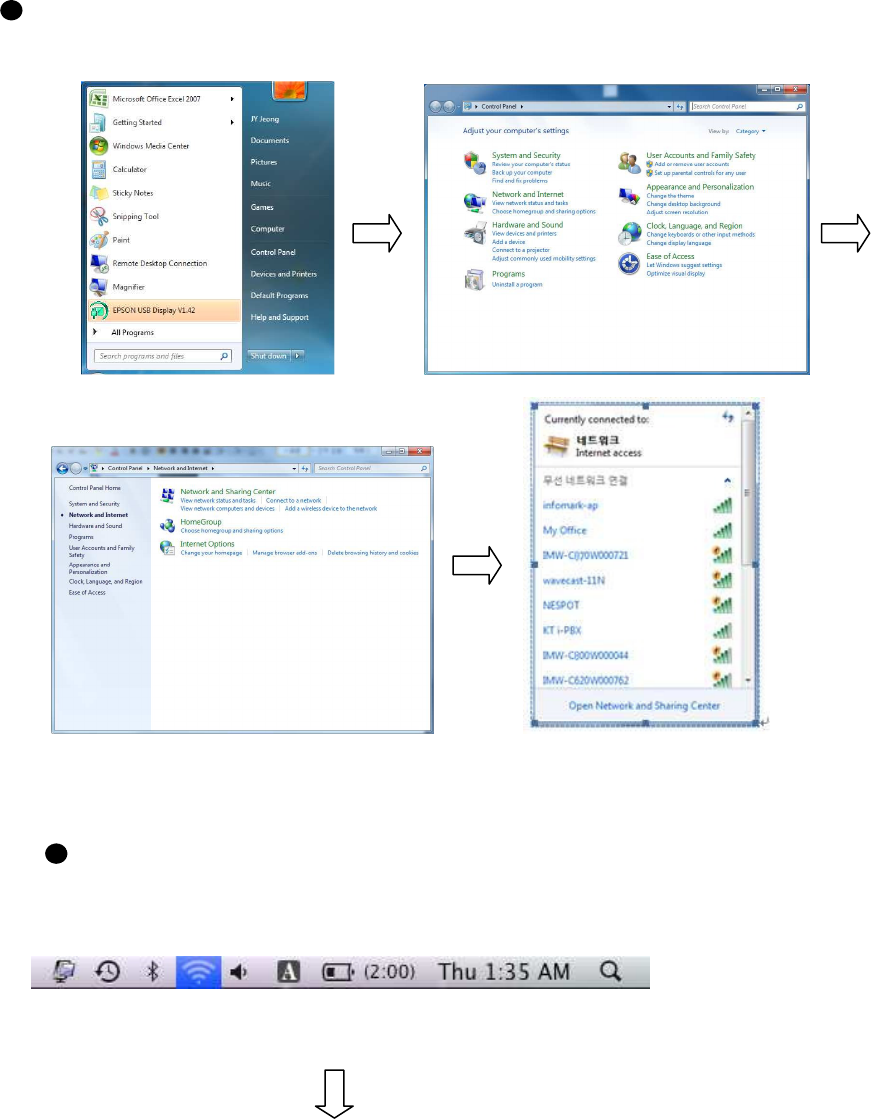
Setting with Window 7
<Start> <Control Panel> <Network and Internet> <Connect to Network>
Choose the WiFi AP of IMW-C870W in the list
Setting with Mac OS
Click the wireless Icon on the menu Choose the WiFi AP of IMW-C870W in the list
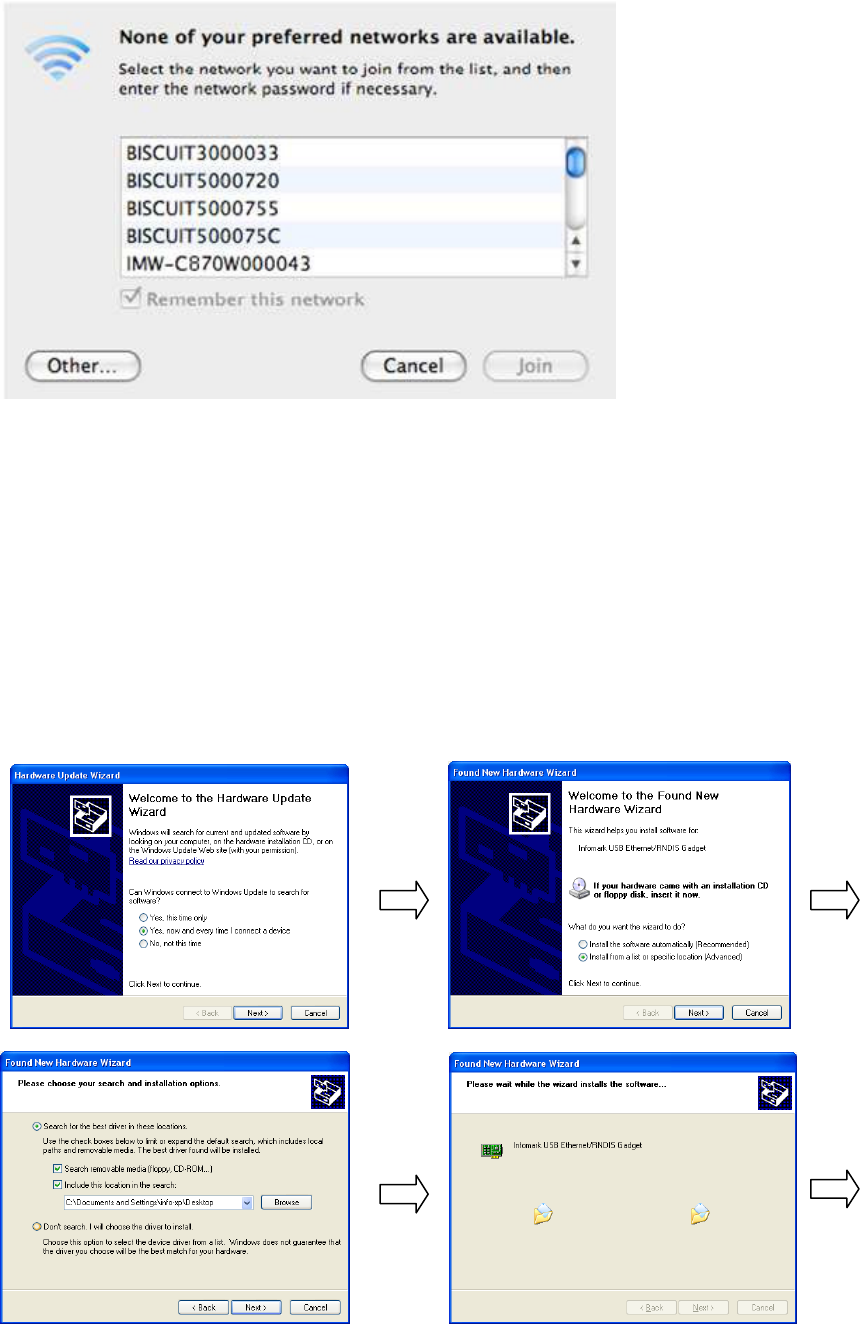
Setting of USB (RNDIS)
Notice :
1. Your PC connected to web server of IMW-C870W through WiFi.
2. Driver of RNDIS can down load from web sever of IMW-C870W .
3. Refer to USB Driver Page No. XX for download.
Setting with Window XP
1. IMW-C870W should be connected with PC by USB cable.
2. Below is each step of RNDIS installation.
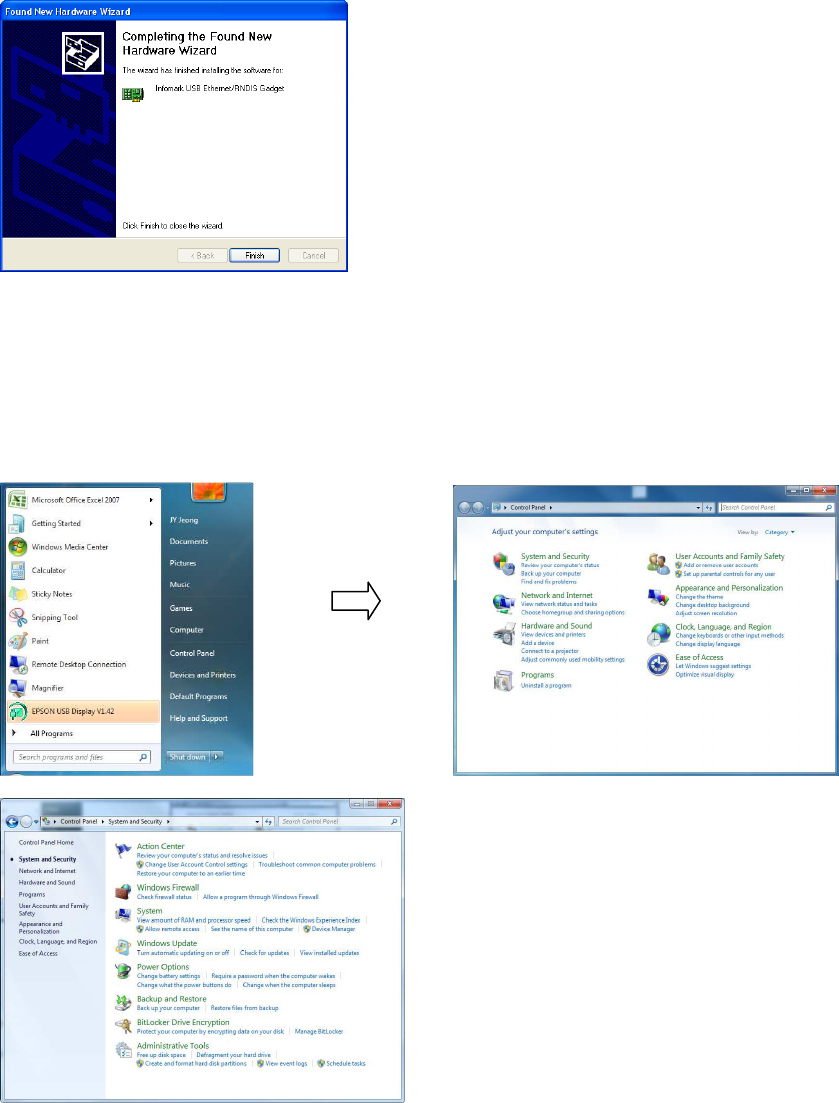
Setting with Window 7
1. IMW-C870W should be connected with PC by USB cable.
2. Below is each step of RNDIS installation.
<Start> <Control Panel> <Network and Internet> <Connect to Network>
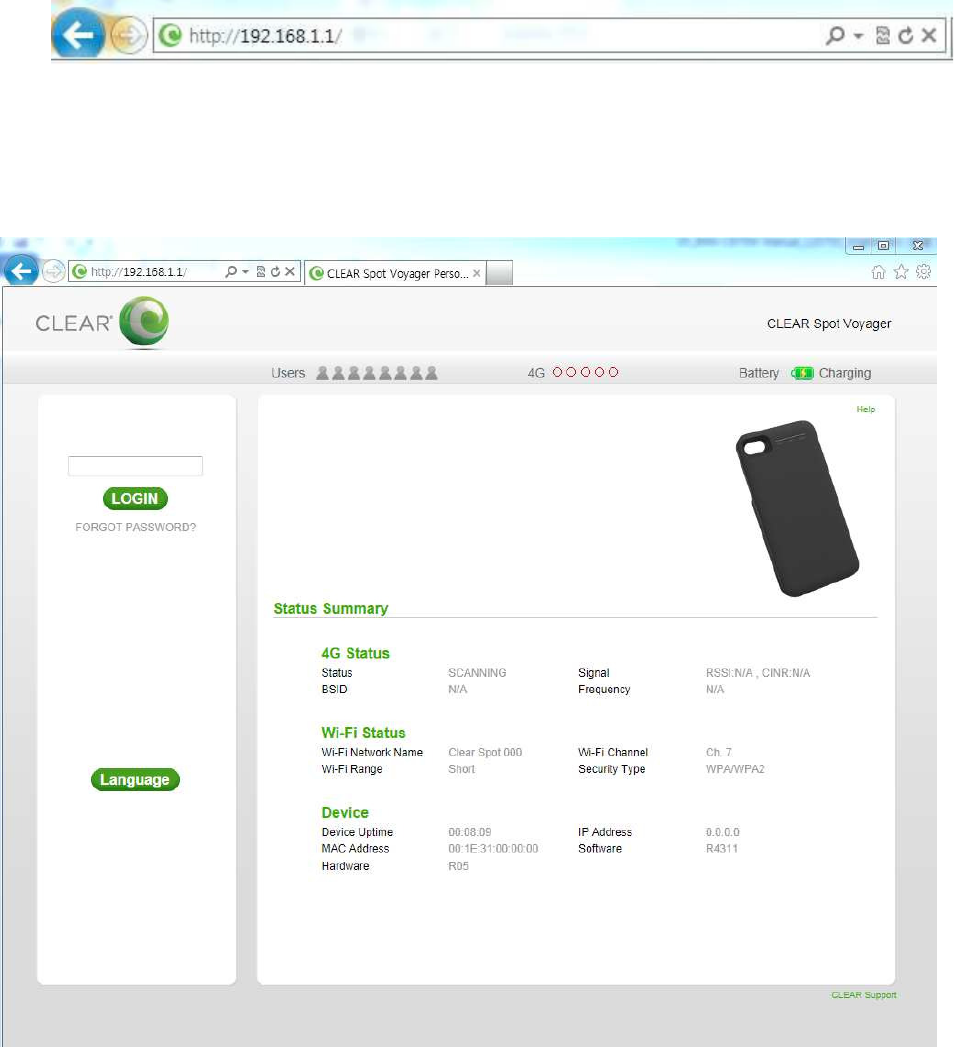
Chapter 4 Configuring CM
Connect to Web CM (Web Connection Manager)
Start CM
- Use web browser to connect Web CM
- Type Address 192.168.1.1
※ Microsoft Internet Explorer is recommended
Input ID
- A Pop-up window will requests for specific ID to enter into Web CM
ID : admin
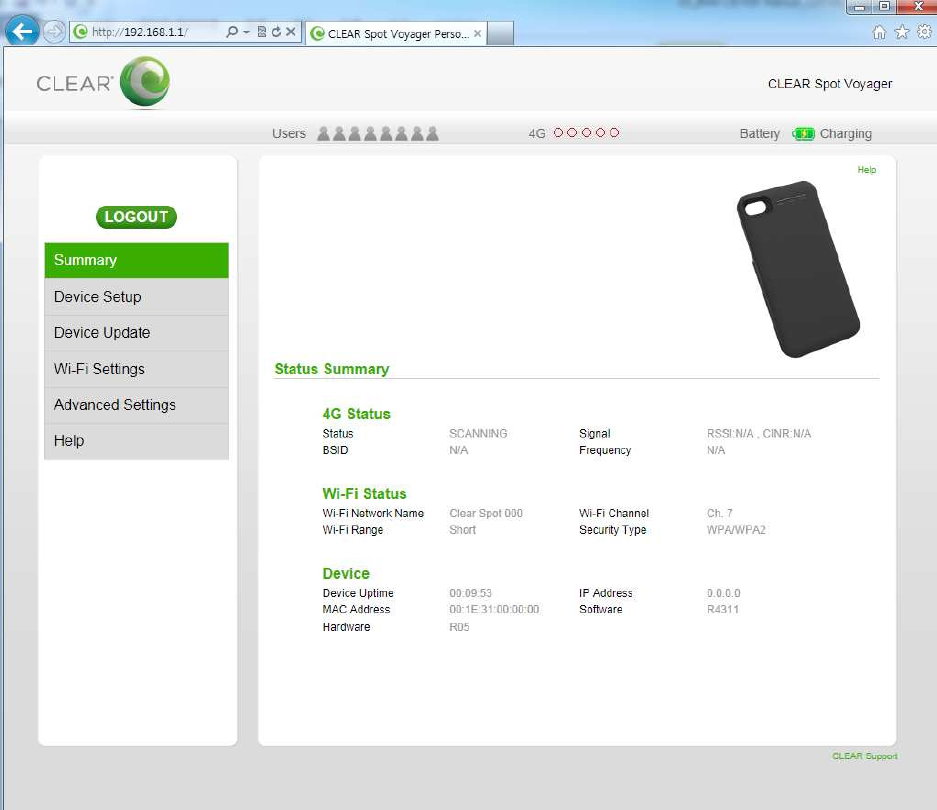
Description of Web User Interface
Status
Display device information and basic configuration of device.
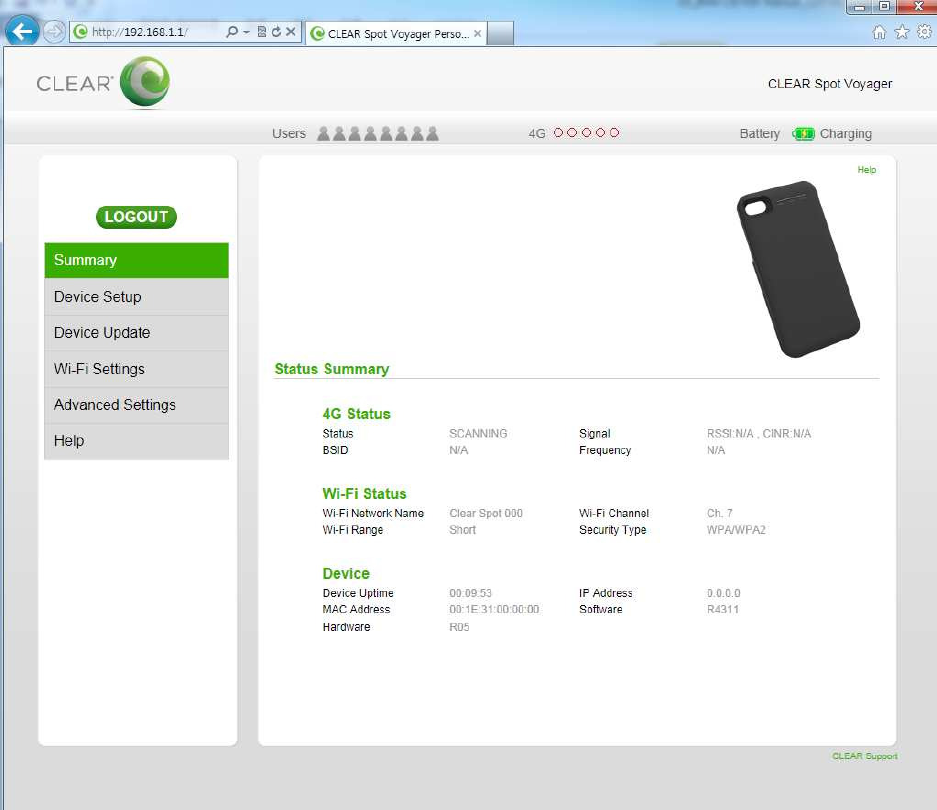
Device Setup
Setup Wizard
Setting Web CM Password, Time Zone and SSID/WPA security code
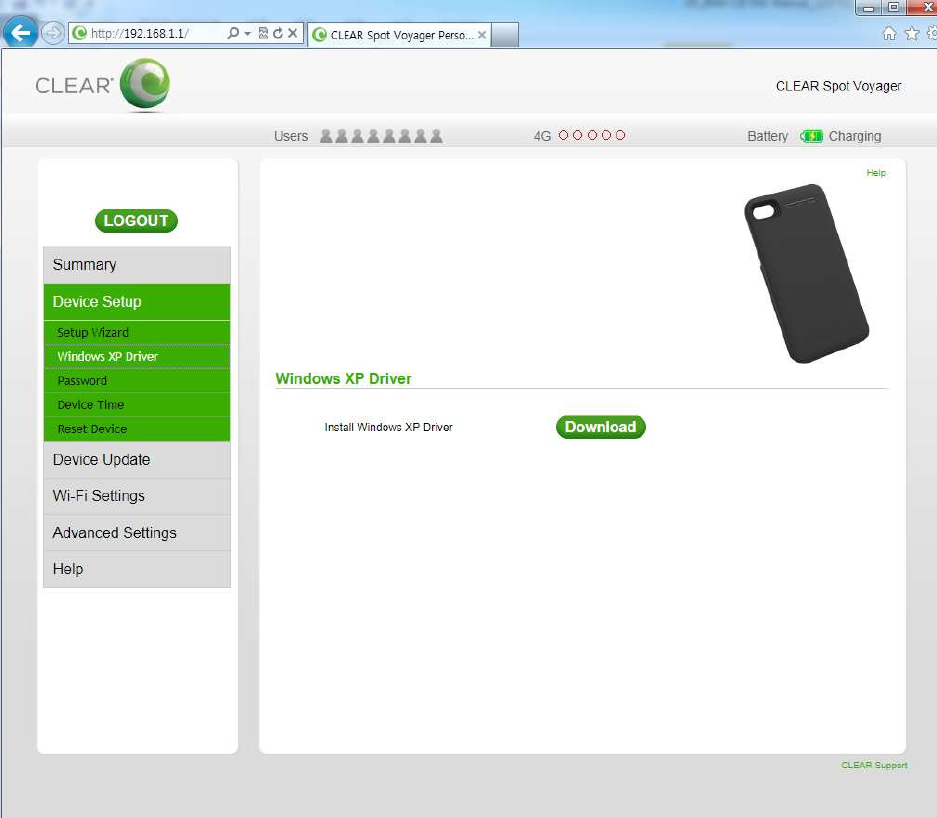
Windows XP driver
The RNDIS driver can download on this page for Windows XP.
In case of Windows Vista and Windows 7, the driver is supported.
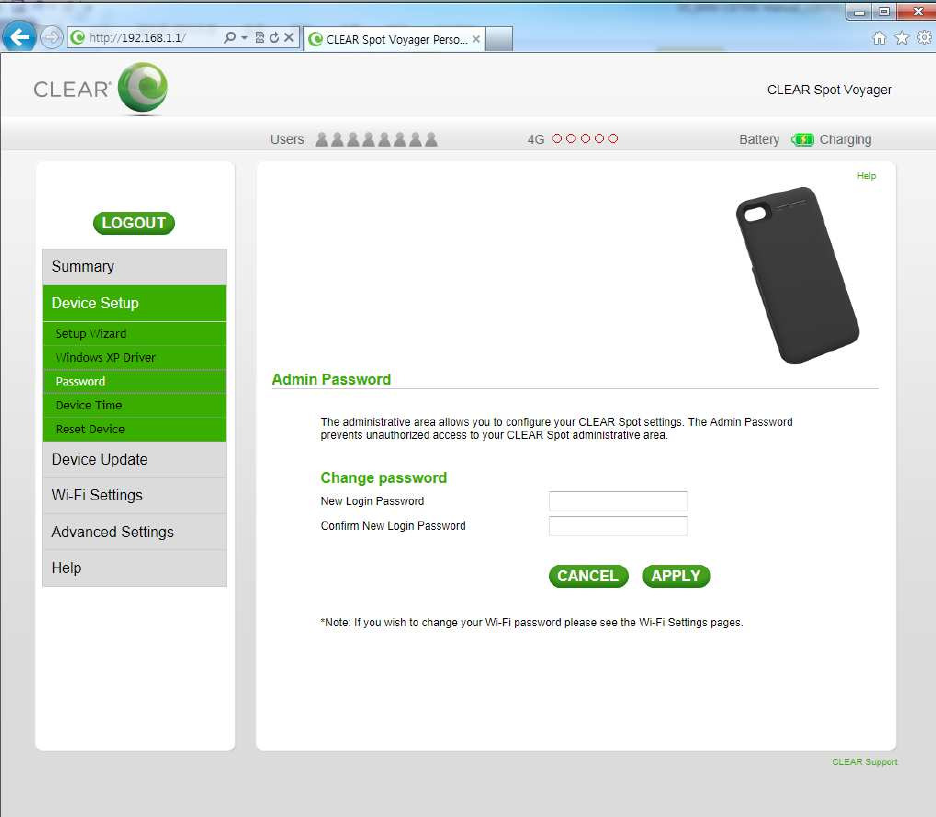
Password
The password can be changed.
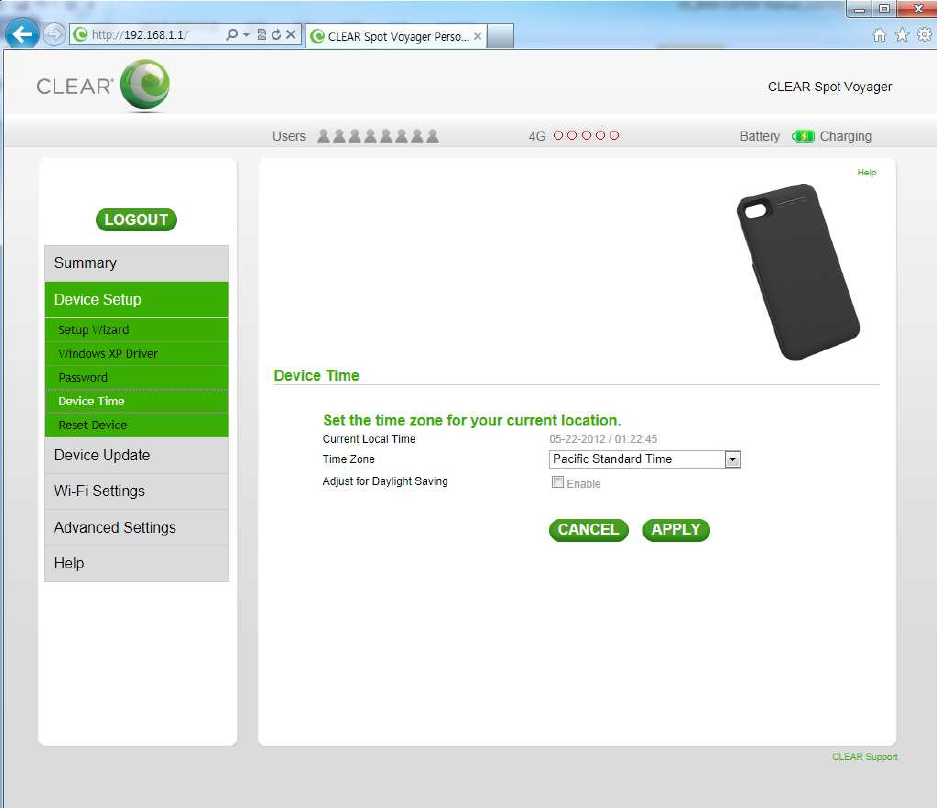
Device Time
Setting Time Zone.
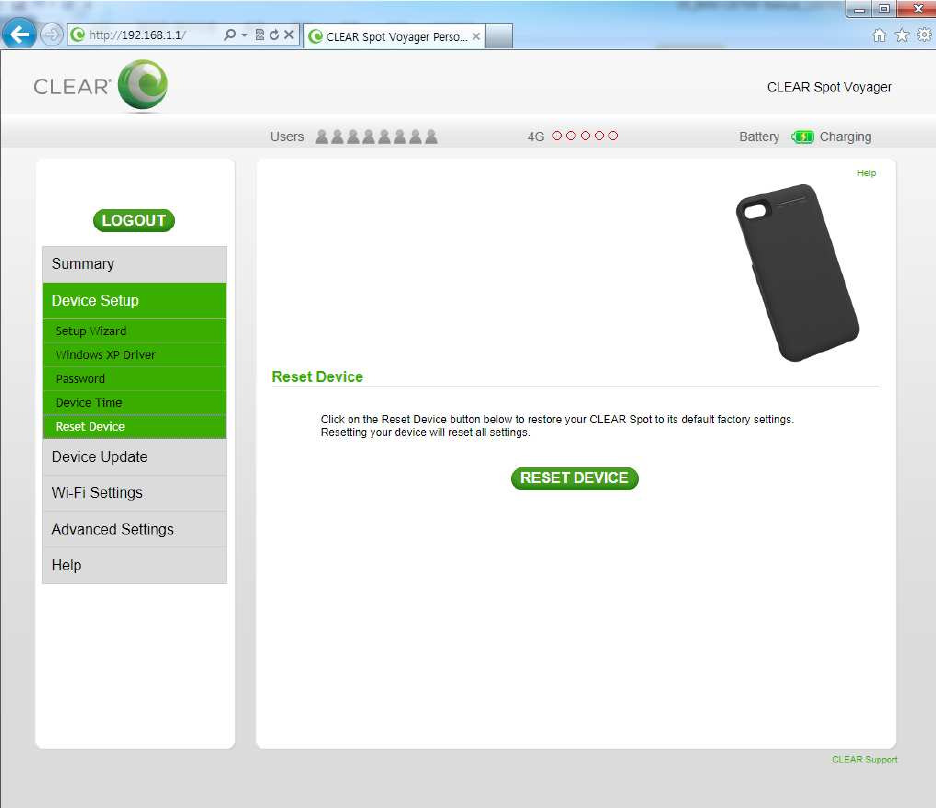
Reset Device
If <RESET DEVICE> button is clicked, the device has to roll back to factory default configuration.
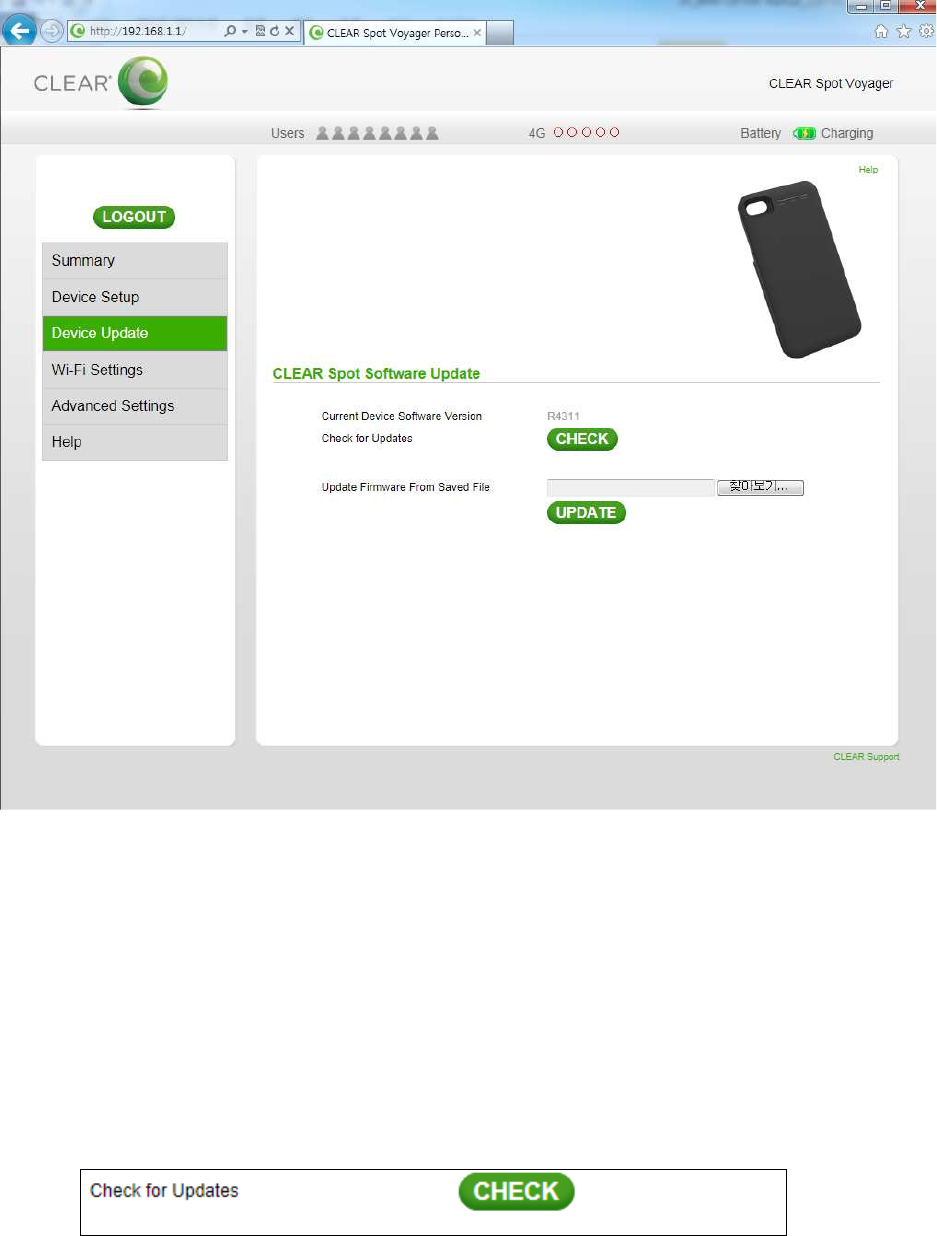
■ Device Update
The device supports to auto FOTA, maual FOTA and user upgrading
Auto FOTA upgrading
In case that new firmware exists in FOTA server. This device check new firmware version and if
there is new firmware in FOTA server, this device is going to be upgraded automatically.
The WiMAX LED is blinking with red color during upgrading.
Manual FOTA upgrading
In case that new firmware exists in FOTA server. User can check and upgrade new firmware in
FOTA server manually.
The WiMAX LED is blinking with red color during upgrading.
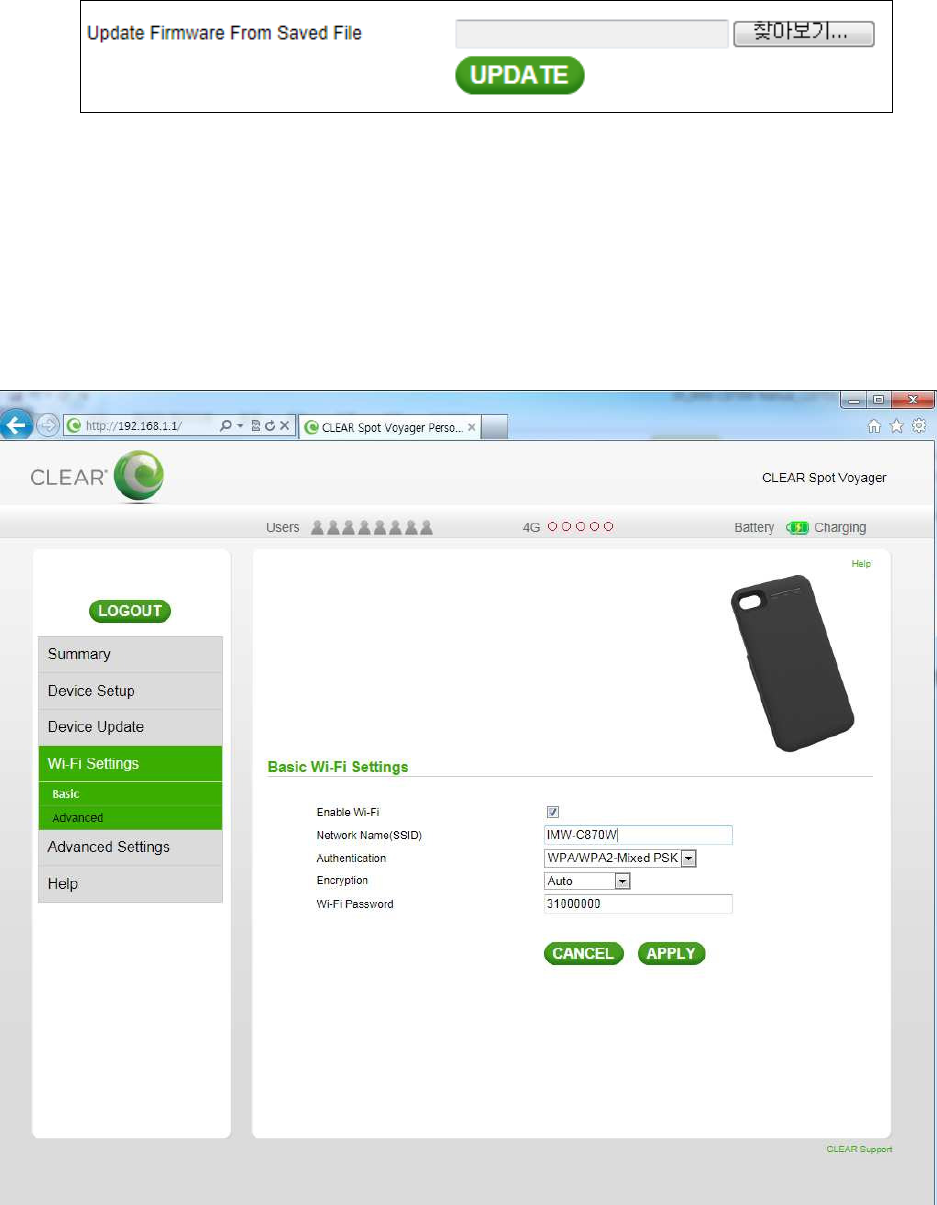
User upgrading
In case that operator releases new firmware to end user, user can upgrade by himself
■ Wi-Fi Settings
Basic
Set basic configuration of Wifi.
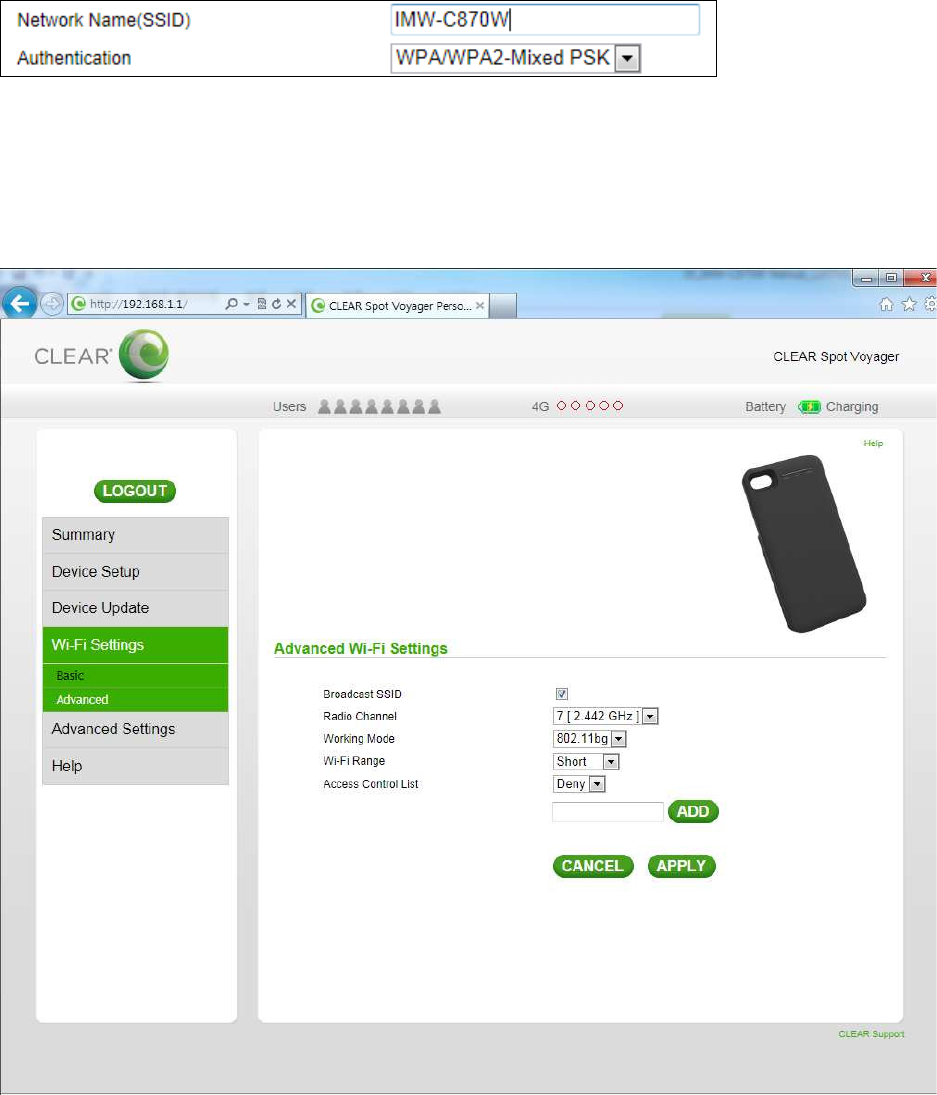
-. Network Name(SSID) : Set name of WiFi AP.
-. Security method : Set security method for WiFi.
-. The set configure should be saved after clicking <APPLY>button.
Advadced
Setting WiFi configuartion details.
-. Broadcast SSID : Show name of WiFi AP
-. Radio Channel : WiFi channel can be changed
-. Working Mode : WiFi mode can be changed
-. Tx Power : The signal level of Wi-Fi can be changed
-. Access Control List : Mac address filtering of WiFi client device
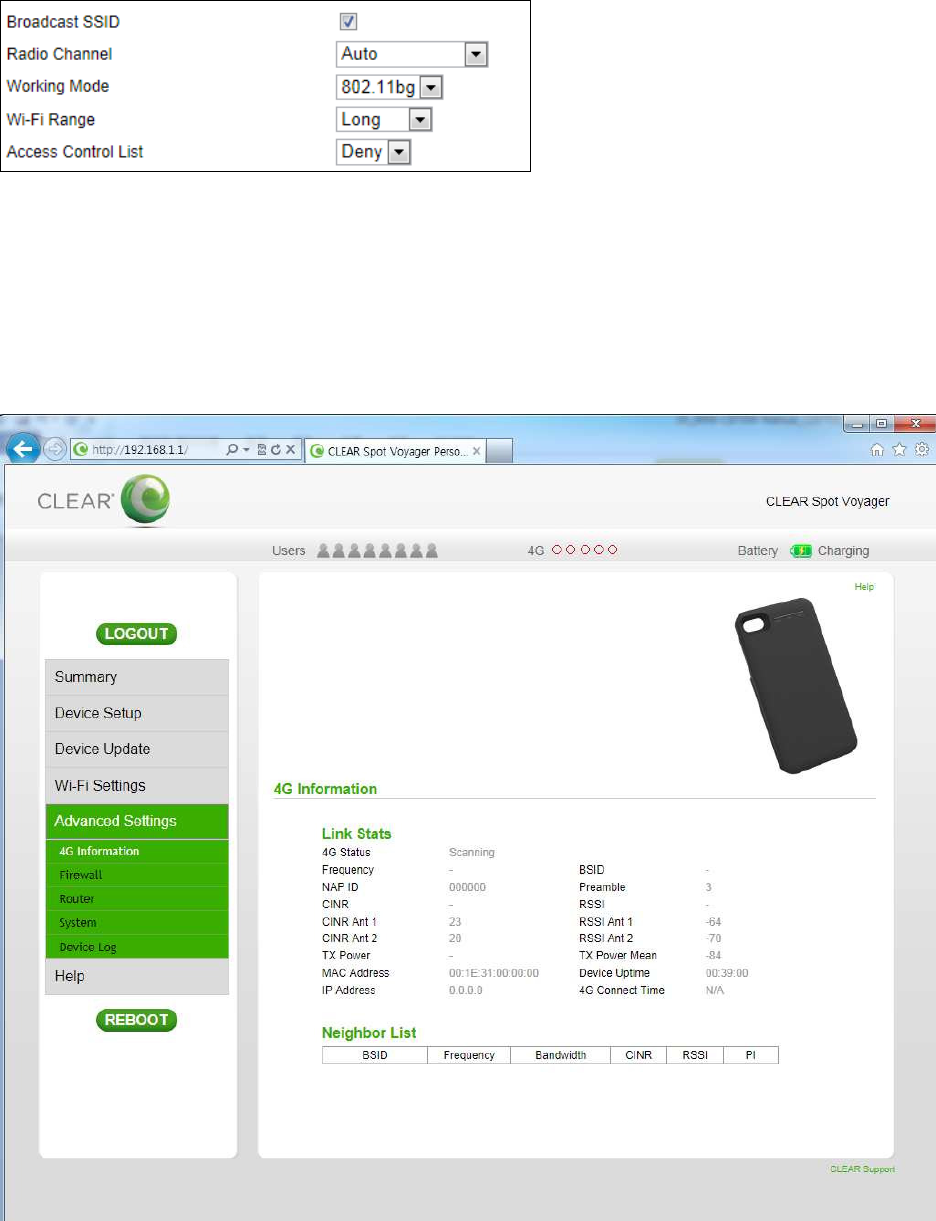
■ Advanced Settings
4G Information
Connected status and information of device display
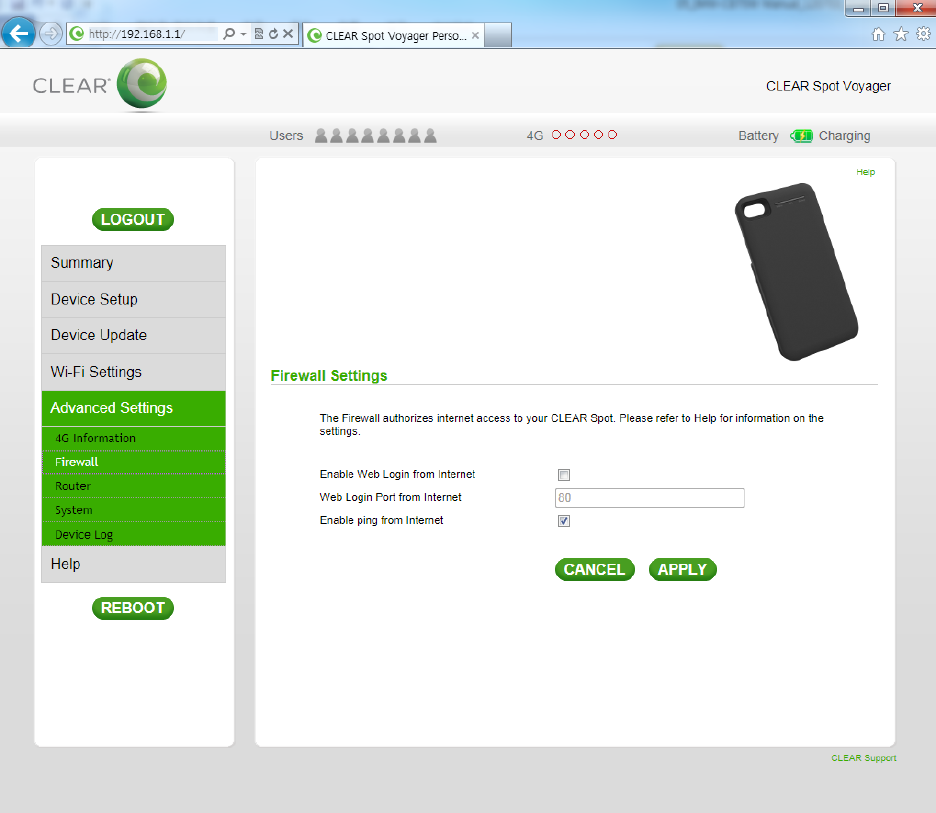
Firewall
Setting the firewall
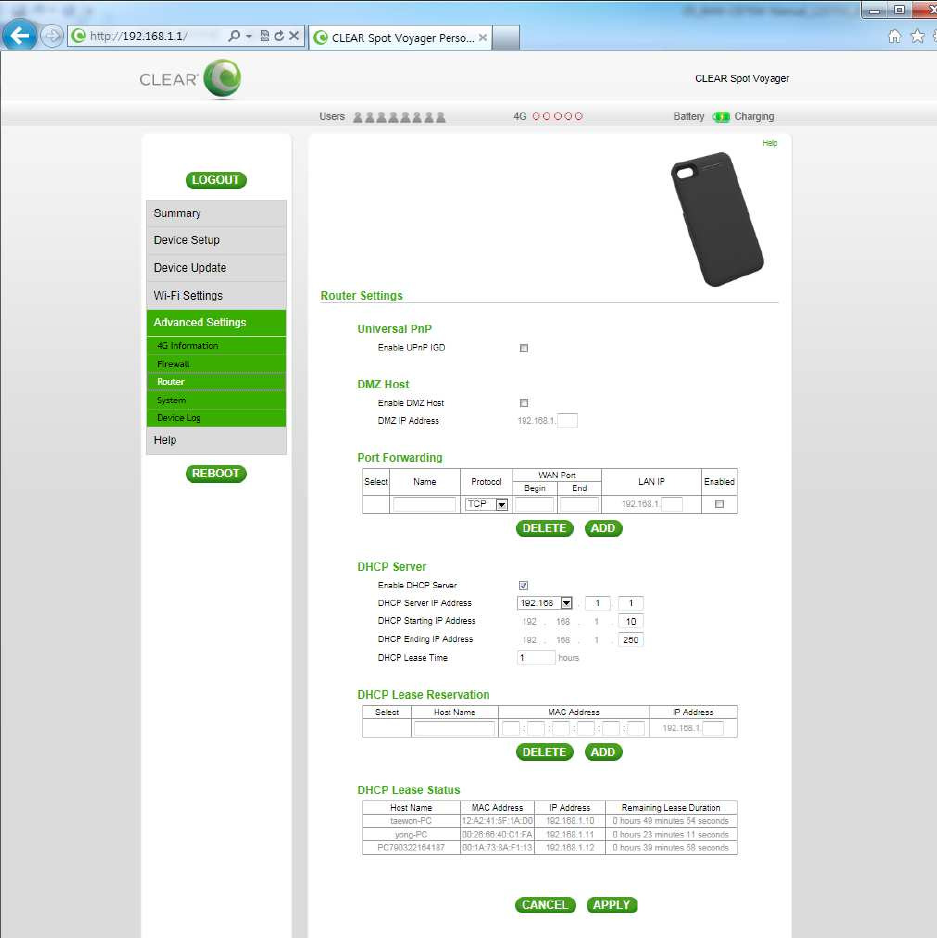
Router
Setting additional functions of router.
・Universal PnP:Set the port number for UPnP connection.
This device should be restarted after changing configuration.
・VPN Passthrough : Set VPN Passthrough.
This device should be restarted after changing configuration.
・DMZ Host:Set IP address of device for DMZ function.
・Port Forwarding:Set range of port number and protocol(UDP/TCP/BOTH).
・DHCP Server : Chang DHCP server of local network.
・DHCP Lease Reservation : Fix IP address base on a MAC address.
・DHCP Lease Status : Indicate current status of DHCP Lease Reservation.
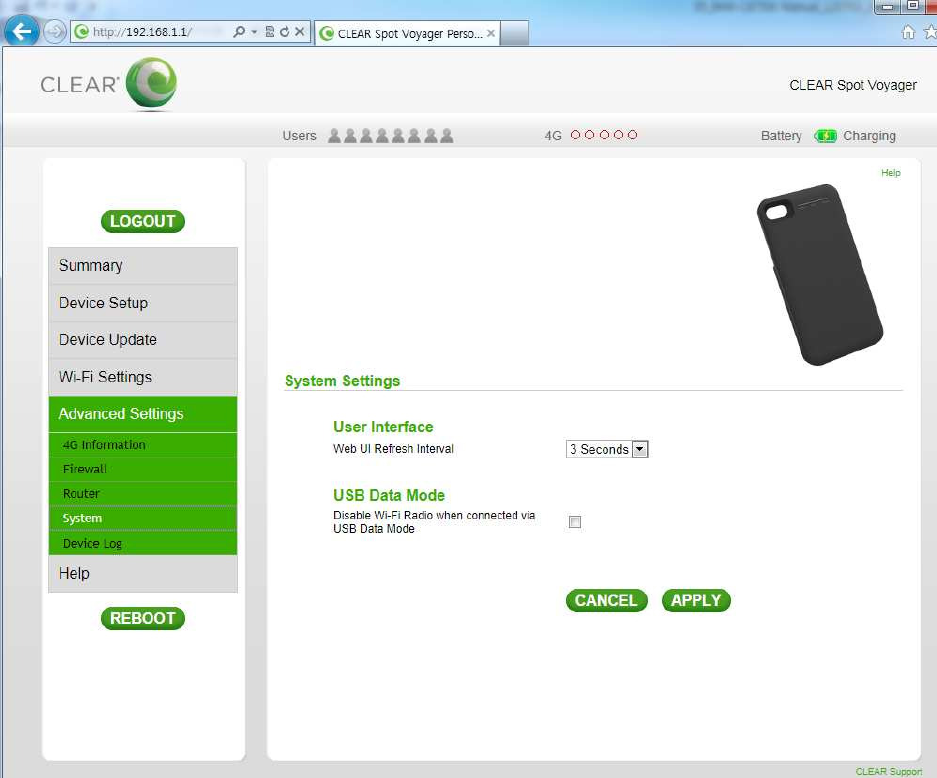
System
Setting system configuration of device.
・User Interface : Change refresh interval of WebUI from 1 sec to 5sec.
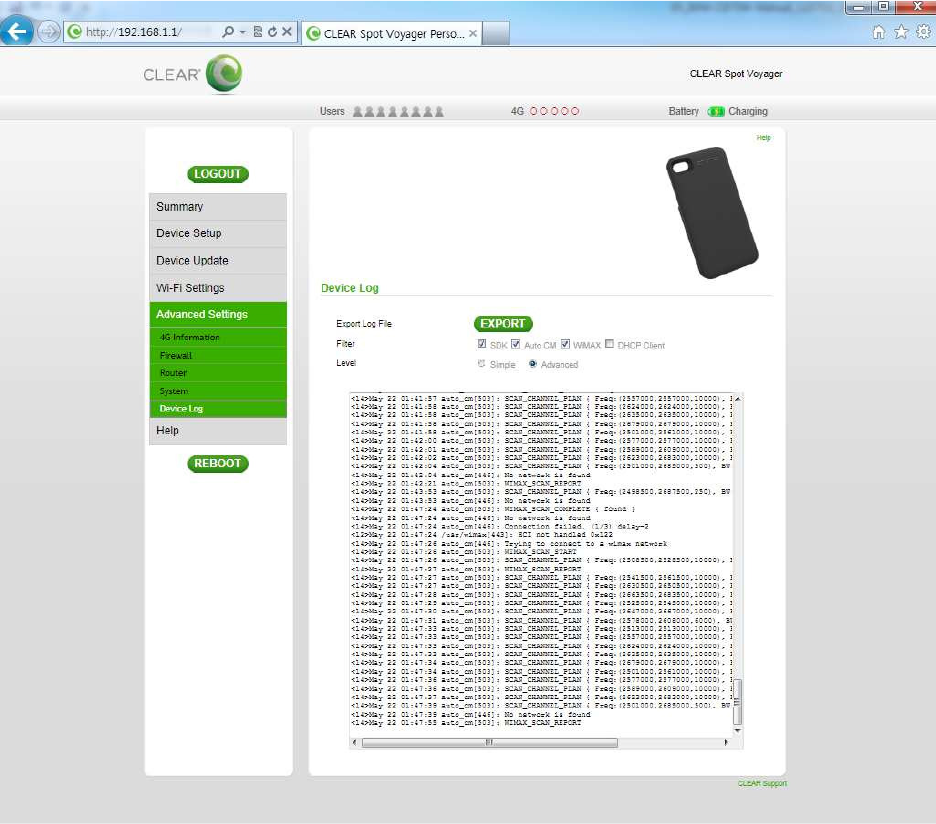
Device Log
The device log can be shown and download on the PC.
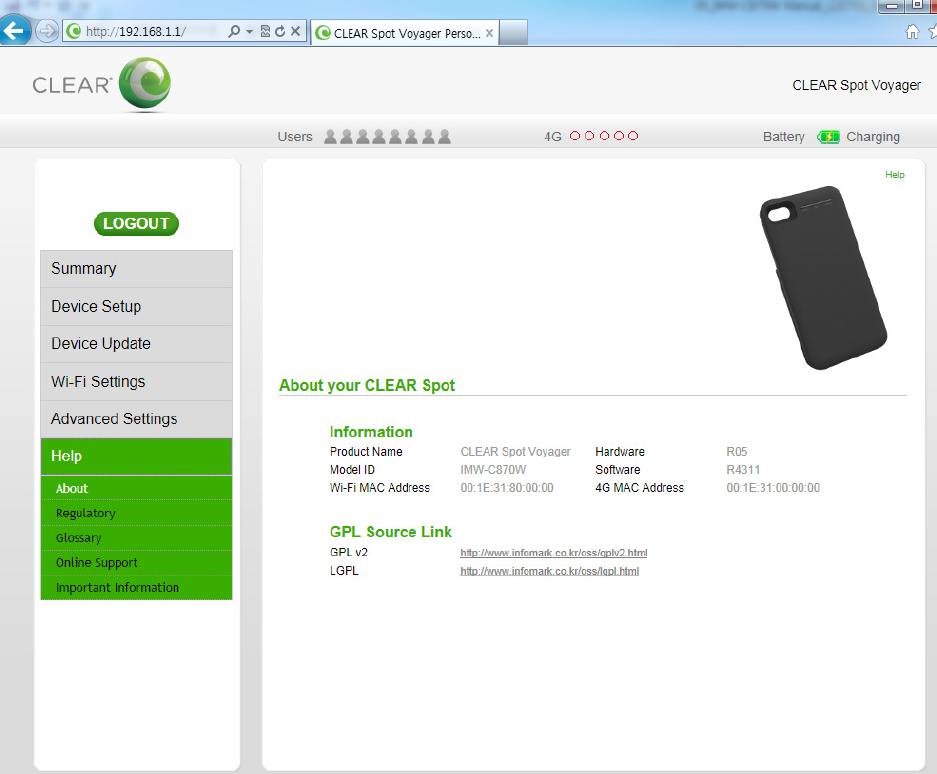
■ Help
Provide device information, Regulatory, Glossary, Online Support and Important Information.
Federal Communication Commission Interference Statement
This device complies with part 15 of the FCC Rules. Operation is subject to the following
two conditions: (1) This device may not cause harmful interference, and (2) this device
must accept any interference received, including interference that may cause undesired
operation.
This device has been tested and found to comply with the limits for a Class B digital
device, pursuant to Part 15 of the FCC Rules. These limits are designed to provide
reasonable protection against harmful interference in a residential installation. This
equipment generates, uses and can radiated radio frequency energy and, if not installed
and used in accordance with the instructions, may cause harmful interference to radio
communications. However, there is no guarantee that interference will not occur in a
particular installation If this equipment does cause harmful interference to radio or
television reception, which can be determined by turning the equipment off and on, the
user is encouraged to try to correct the interference by one or more of the following
measures:
Reorient or relocate the receiving antenna.
Increase the separation between the equipment and receiver.
Connect the equipment into an outlet on a circuit different from that to which the
receiver is connected.
Consult the dealer or an experienced radio/TV technician for help.
FCC Caution:
Any Changes or modifications not expressly approved by the party responsible for
compliance could void the user‘s authority to operate the equipment.
The antenna(s) used for this transmitter must not be co-located or operating in conjunction
with any other antenna or transmitter.
Note: The country code selection is for non-US model only and is not available to all US
model. Per FCC regulation, all WiFi product marketed in US must fixed to US operation
channels only.
4
44
4RF Exposure Information (SAR)
This device meets the government’s requirements for exposure to radio waves.
This device is designed and manufactured not to exceed the emission limits for exposure to
radio frequency (RF) energy set by the Federal Communications Commission of the U.S.
Government.
The exposure standard for wireless device employs a unit of measurement known as the
Specific Absorption Rate, or SAR. The SAR limit set by the FCC is 1.6W/kg.
*
Tests for SAR
are conducted using standard operating positions accepted by the FCC with the device
transmitting at its highest certified power level in all tested frequency bands. Although the
SAR is determined at the highest certified power level, the actual SAR level of the device
while operating can be well below the maximum value. This is because the device is designed
to operate at multiple power levels so as to use only the poser required to reach the network.
In general, the closer you are to a wireless base station antenna, the lower the power output.
The highest SAR value for the model device as reported to the FCC when tested for use at
worn on the body, as described in this user guide, is 1.134 W/kg (Body-worn measurements
differ among device models, depending upon available accessories and FCC requirements.)
While there may be differences between the SAR levels of various devices and at various
positions, they all meet the government requirement.
The FCC has granted an Equipment Authorization for this model device with all reported
SAR levels evaluated as in compliance with the FCC RF exposure guidelines. SAR
information on this model device is on file with the FCC and can be found under the Display
Grant section of www.fcc.gov/oet/ea/fccid after searching on FCC ID: YCO-IMW-C870W.
For body worn operation, this device has been tested and meets the FCC RF exposure
guidelines for use with an accessory that contains no metal and be positioned a minimum of 1
cm from the body. Use of other accessories may not ensure compliance with FCC RF
exposure guidelines.